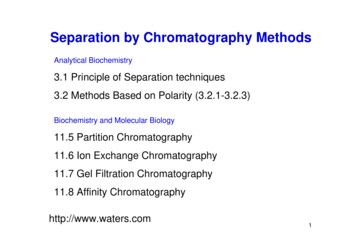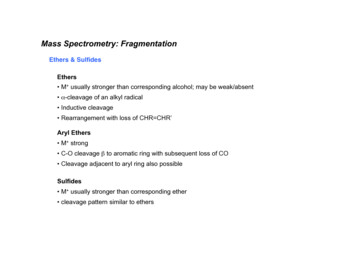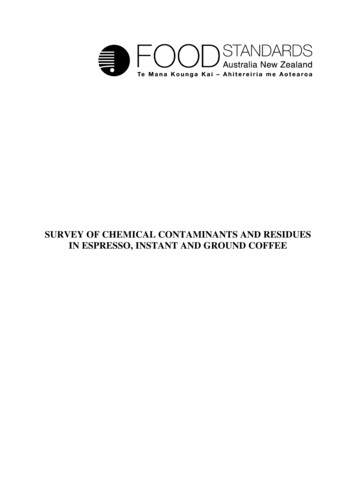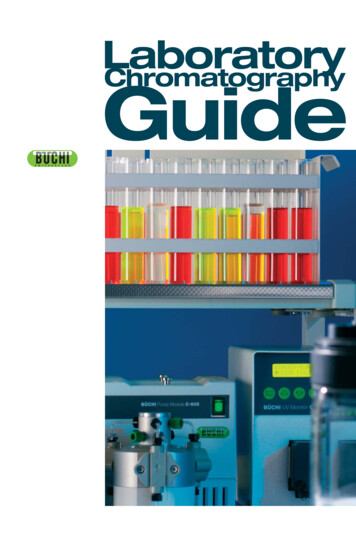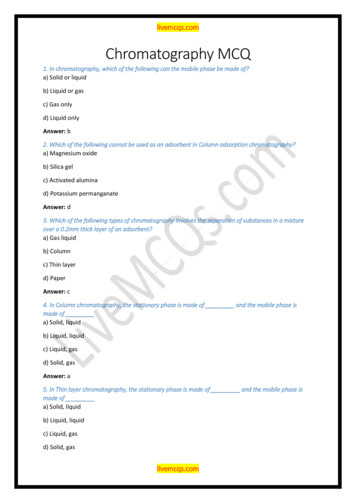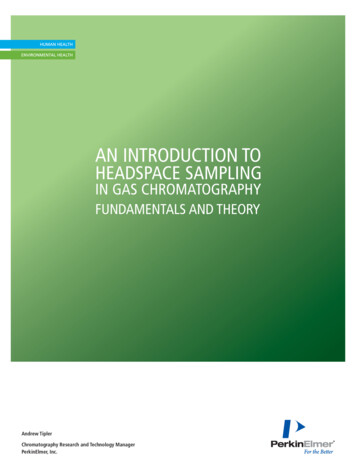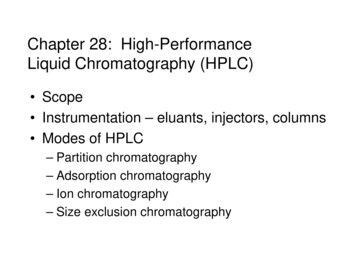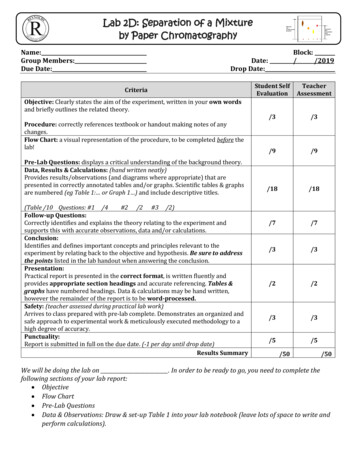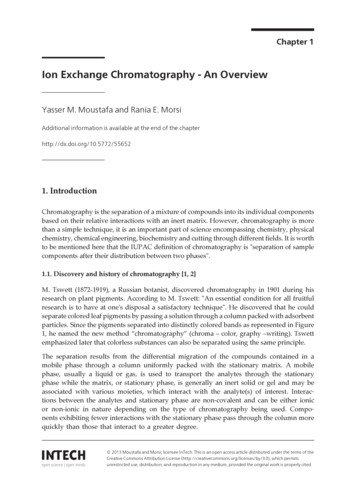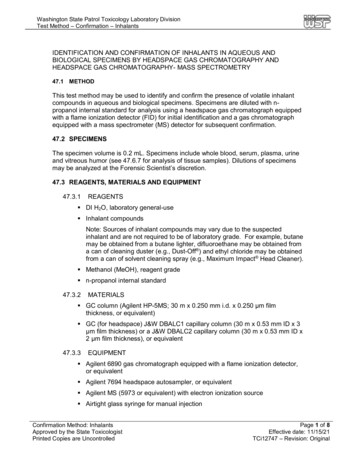
Transcription
Washington State Patrol Toxicology Laboratory DivisionTest Method – Confirmation – InhalantsIDENTIFICATION AND CONFIRMATION OF INHALANTS IN AQUEOUS ANDBIOLOGICAL SPECIMENS BY HEADSPACE GAS CHROMATOGRAPHY ANDHEADSPACE GAS CHROMATOGRAPHY- MASS SPECTROMETRY47.1 METHODThis test method may be used to identify and confirm the presence of volatile inhalantcompounds in aqueous and biological specimens. Specimens are diluted with npropanol internal standard for analysis using a headspace gas chromatograph equippedwith a flame ionization detector (FID) for initial identification and a gas chromatographequipped with a mass spectrometer (MS) detector for subsequent confirmation.47.2 SPECIMENSThe specimen volume is 0.2 mL. Specimens include whole blood, serum, plasma, urineand vitreous humor (see 47.6.7 for analysis of tissue samples). Dilutions of specimensmay be analyzed at the Forensic Scientist’s discretion.47.3 REAGENTS, MATERIALS AND EQUIPMENT47.3.1REAGENTS DI H2O, laboratory general-use Inhalant compoundsNote: Sources of inhalant compounds may vary due to the suspectedinhalant and are not required to be of laboratory grade. For example, butanemay be obtained from a butane lighter, difluoroethane may be obtained froma can of cleaning duster (e.g., Dust-Off ) and ethyl chloride may be obtainedfrom a can of solvent cleaning spray (e.g., Maximum Impact Head Cleaner). Methanol (MeOH), reagent grade n-propanol internal standard47.3.2MATERIALS GC column (Agilent HP-5MS; 30 m x 0.250 mm i.d. x 0.250 µm filmthickness, or equivalent) GC (for headspace) J&W DBALC1 capillary column (30 m x 0.53 mm ID x 3µm film thickness) or a J&W DBALC2 capillary column (30 m x 0.53 mm ID x2 µm film thickness), or equivalent47.3.3EQUIPMENT Agilent 6890 gas chromatograph equipped with a flame ionization detector,or equivalent Agilent 7694 headspace autosampler, or equivalent Agilent MS (5973 or equivalent) with electron ionization source Airtight glass syringe for manual injectionConfirmation Method: InhalantsApproved by the State ToxicologistPrinted Copies are UncontrolledPage 1 of 8Effective date: 11/15/21TCi12747 – Revision: Original
Washington State Patrol Toxicology Laboratory DivisionTest Method – Confirmation – Inhalants Cap crimper Hamilton Microlab 600 Autopipette, Hamilton Automatic Diluter, orequivalent Headspace autosampler vials (10 mL) and crimp caps Heating block47.4 STANDARDS47.4.1Inhalant compounds are obtained as described in 47.3.1.47.4.2Internal standard (n-propanol) is prepared and verified according to theProcedure for the Verification of n-Propanol Internal Standard (PTis12501).47.5 CALIBRATORS AND CONTROLS47.5.1CALIBRATORS47.5.1.147.5.2As quantitation of inhalants is not performed, no calibrators arerequired.CONTROLS47.5.2.1One negative control is included in the batch, containing n-propanolinternal standard and DI H2O.47.5.2.2At least two positive controls are included in the batch, used tobracket case specimens. Examples are listed below.a. Where all specimens analyzed are expected to contain a singleinhalant (e.g., difluoroethane), two positive controls for thatinhalant are prepared (as described in 47.6.2 and 47.6.3) andanalyzed, bracketing specimens in the batch.b. Where batch specimens are expected to contain two differentinhalants (e.g., difluoroethane, ethyl chloride), one positive controlfor each is prepared (as described in 47.6.2 and 47.6.3). Onepositive control is analyzed prior to specimens, and one isanalyzed at the end of the batch in order to bracket specimens.c. Where specimens are expected to contain more than two differentinhalants, one positive control for each is prepared (as describedin 47.6.2 and 47.6.3). One positive control is analyzed prior tospecimens, and one is analyzed at the end of the batch in order tobracket specimens. The third positive control may be analyzed atany point within the batch.d. Controls (including both positive and negative) must make up 10%of the batch (based on number of case specimens). Where morethan 20 case specimens are analyzed in a batch, a third positivecontrol must be prepared and analyzed mid-batch.Confirmation Method: InhalantsApproved by the State ToxicologistPrinted Copies are UncontrolledPage 2 of 8Effective date: 11/15/21TCi12747 – Revision: Original
Washington State Patrol Toxicology Laboratory DivisionTest Method – Confirmation – Inhalants47.6 SAMPLE PREPARATIONNOTE: Independent aliquots of the specimen, controls, and blanks must be takenfor initial identification and subsequent confirmation of the inhalant compound.47.6.1Label headspace vials for each member of the test batch (e.g., blank,negative control, positive controls, case specimens). Batch may be set upaccording to the following suggested sequence:1. Blank2. Positive Control3. Blank to eliminate carryover(additional blanks, as needed, to eliminatecarryover)4. Negative Control5. Specimen*6. Blank to eliminate carryover (as needed)7. Positive Control8. Blank to eliminate carryover(additional blanks, as needed, to eliminatecarryover)*Repeat step 5 and 6 for each specimen.NOTE: The number of blank injections following the positive control mayvary, depending on the inhalant compound being injected. A sufficientnumber of blanks should be injected until the inhalant is not detected. Notethat carryover is not likely with the HSGC acquisition method, but is morelikely to occur when analyzing specimens/positive controls using the GC-MSacquisition method.NOTE: It is advisable to run a blank after the case specimen if carryover issuspected. Multiple blanks may be run as necessary to eliminate carryover.Blanks may be analyzed at the Forensic Scientist’s discretion.47.6.2Prepare concentrated positive control standards from inhalant sources (e.g.,aerosol can):a. Label three headspace vials for each inhalant being analyzed in thebatch; one for the concentrated control (prepared directly from source)and one each for dilution 1 and dilution 2. Cap and seal the emptydilution 1 and dilution 2 vials.Note: Serial dilutions are utilized to prevent saturation of the volatile(specimens, inhalant, etc.) on the column and to preventcontamination.b. Add a small amount of the inhalant into the vial labeled as theconcentrated control and immediately cap and seal. Allowequilibration for at least 10 seconds before preparing dilution 1.Confirmation Method: InhalantsApproved by the State ToxicologistPrinted Copies are UncontrolledPage 3 of 8Effective date: 11/15/21TCi12747 – Revision: Original
Washington State Patrol Toxicology Laboratory DivisionTest Method – Confirmation – Inhalantsc. Using an airtight syringe, remove a full syringe of air (approximately 1mL) from the equilibrated concentrated control vial and dispense intothe dilution 1 vial. Allow to equilibrate for at least 10 seconds beforepreparing dilution 2.d. Using an airtight syringe, remove a full syringe of air (approximately 1mL) from the equilibrated dilution 1 vial and dispense into the dilution2 vial.47.6.3Prepare the batch positive controls from the dilution 2 vial:a. Using the auto-pipetter, aliquot 200 µL of DI H2O and 2 mL of npropanol internal standard into the positive control vials. Cap and sealthe vials.b. Using an airtight syringe, remove a full syringe of air (approximately 1mL) from the dilution 2 vial and dispense into the first positive controlvial. Repeat for additional positive controls, removing a fresh, fullsyringe of air (approximately 1 mL) for each.47.6.4Equilibrate case specimens to room temperature and mix before openingunder a biohazard hood. Blood specimens are inspected to ensure theblood is mobile.47.6.5Aliquot approximately 2.2 mL DI H2O into the vial labeled blank. Cap andseal the vial.47.6.6Using the auto-pipetter, aliquot 200 µL of DI H2O and 2 mL of the internalstandard solution into the negative control vial. Cap and seal the vial.47.6.7Using the auto-pipetter, aliquot 200 µL of the specimens and 2 mL of theinternal standard solution into the respectively labeled vials. Cap and sealeach vial.Note: Non-homogenized tissue specimens (such as a lung section), may bereceived in sealed bags or septum jars. Prepare a vial in the same manneras a negative control, sample a full syringe of air from the septum jar, andinject into the appropriately labeled headspace vial. It may be necessary toopen the bag/jar and remove a small sample of the lung, adding it to theheadspace vial. Section sampling of the tissue samples will be documentedin the batch paperwork.47.6.8Between each aliquot, rinse and wash the pipette tip appropriately (e.g.,rinse pipette tip with diluted bleach and/or DI H2O. Repeat if necessary.)47.7 INSTRUMENTAL PARAMETERS (HSGC) Load and edit sequence on the headspace gas chromatograph. Enter the blanks,controls and specimens into the sequence table. All samples are identified asSample in the Sample Type column.Confirmation Method: InhalantsApproved by the State ToxicologistPrinted Copies are UncontrolledPage 4 of 8Effective date: 11/15/21TCi12747 – Revision: Original
Washington State Patrol Toxicology Laboratory DivisionTest Method – Confirmation – Inhalants Place each headspace vial in its respective position on the headspaceautosampler and verify this placement against the sequence log. Acquisition method – HSGC: BLDALCO for all. [Note: The method name maycontain a numeric suffix to differentiate between instruments; for exampleBLDALCO1 for headspace instrument 1. A copy of the acquisition method for eachheadspace instrument is available at the instrument.]47.8 VIAL PREPARATION/INSTRUMENTAL PARAMETERS (GC-MS) Heat prepared headspace vials to approximately 70 C prior to injection into theGC-MS. Using an airtight glass syringe, remove approximately 1mL of the headspace airfrom the headspace vial and manually inject the sample into the GC-MS inlet. Acquisition method – GC-MS: VOL for most compounds. Compounds with a laterelution time may be analyzed using the VOL-LONG method.47.9DATA ANALYSISFor HSGC, printed reports for each vial in the batch are generated for review, alongwith a copy of the sequence table and worklist. For GC-MS, chromatograms areprinted for each injection, with mass spectral matches printed for target compoundpeaks in controls and specimens.47.10 CRITERIA FOR BATCH ACCEPTANCEIf the analysis of the batch meets the criteria listed below, the results for thespecimens are accepted.47.10.1 BlankThe blank injection at the beginning of the batch, and any blanks directlypreceding specimens, shall be devoid of any significant peaks 1,2. These criteriado not apply to blanks run after positive controls/semi-quant calibrators for thepurpose of eliminating carryover.47.10.2 Controls/Semi-quant Calibrators The negative control(s) shall be devoid of any significant peaks other than npropanol2. Identification is based on acceptable retention time matching andan integrated, symmetrical peak. All negative controls must meet thesecriteria for the batch to be accepted. The positive controls shall contain peaks for n-propanol and the inhalantcompound in question2.1Peaks appearing in the blank, calibrators and negative controls that are fully resolved from the inhalantcompound or internal standard are considered extraneous and not significant.2 On the GCMS, each spectrum will show a large air peak at the beginning of each run. This is notconsidered a significant peak.Confirmation Method: InhalantsApproved by the State ToxicologistPrinted Copies are UncontrolledPage 5 of 8Effective date: 11/15/21TCi12747 – Revision: Original
Washington State Patrol Toxicology Laboratory DivisionTest Method – Confirmation – Inhalants47.11 CRITERIA FOR SPECIMEN ACCEPTANCEIf the criteria for batch acceptance have been satisfied, the results of individualcase samples are deemed suitable for reporting if the following criteria aredemonstrated: Any chromatographic peak for the inhalant compound and n-propanol shallappear symmetrical. The retention time for the inhalant compound and n-propanol are 2% ofthose in the first positive control injected. These are inclusive ranges. A mass spectral match of the detected compound is compared to that in anapproved mass spectral library or to a mass spectrum from the positivecontrol. When using a library match, spectrum agreement should be 75 orgreater wherever possible, taking into consideration the appearance andabundance of ions specific to that compound (an extracted ion match maybe necessary). A reference spectrum for the compound found in a publishedarticle, research paper or other reference material may be acceptable if theelectronic library match is not feasible, provided the source is documented.47.12 REPORTINGAll inhalant compounds are reported qualitatively. Individual test results from theHSGC and GC-MS test methods will be entered in LIMS (use HSGC-MSdesignation in LIMS when entering GC-MS confirmation results).47.13 DOCUMENTATION AND REVIEW Analysts will batch their chromatograms, sequence tables (HSGC), and spectralmatches together and submit the batch for both technical and administrativereview. The reviewer will verify that the batch contains all members of the batch,and that all dates are correctly documented. The reviewer will also verify that thebatch meets the criteria for batch acceptance in 47.10. The reviewer will sign and date the batch, indicating that the batch file is completeand the above procedures have been reviewed. Upon completion of the technical and administrative review, the batch is returnedto the analyst. The final batch file shall contain the batch documentation, including positive andnegative controls and all relevant sequence tables and chromatograms. Blanks rundirectly prior to specimens are filed with the specimen which they precede.Confirmation Method: InhalantsApproved by the State ToxicologistPrinted Copies are UncontrolledPage 6 of 8Effective date: 11/15/21TCi12747 – Revision: Original
Washington State Patrol Toxicology Laboratory DivisionTest Method – Confirmation – InhalantsAPPENDIX A - INSTRUMENTAL PARAMETERSHSGC ParametersModeSplit/Splitless InletSplitOven/Column/DetectorCarrier Gas ModeConstant FlowInlet Liner4 mm splitless w/glasswool plugSplit RatioInlet Temperature1:1250 CHS Oven TempHS Loop TempHS Transfer LineTempVial Equilibration70 C85 C125 C10 minCarrier Gas Flow16 mL/minTemperature(constant)Run Time (BLDALCO)Run Time (VOLLONG)GC Cycle TimeFID Detector Temp40 C2.5 min10.0 min3 min250 CGC-MS ParametersGAS CHROMATOGRAPHModeSplit/Splitless InletSplitInlet LinerSplit RatioTemperatureOven/ColumnCarrier Gas ModeConstant Flow4 mm splitless w/glasswool plug30:1250 CCarrier Gas Flow1.5 mL/minGas TypeInitial TemperatureRun Time (VOL)Run Time (VOLLONG)Helium50 C3.0 min10.0 minMASS SPECTROMETERSolvent DelayEM OffsetAcquisition ModeConfirmation Method: InhalantsApproved by the State ToxicologistPrinted Copies are Uncontrolled0.25 minSet in tuneScanMS Quad TemperatureMS Source Temperature150 C230 CPage 7 of 8Effective date: 11/15/21TCi12747 – Revision: Original
Washington State Patrol Toxicology Laboratory DivisionTest Method – Confirmation - InhalantsLIST OF CHANGESRevisionDate11/15/21DescriptionPage NumberThis procedure describes the testing of inhalants in aqueousand biological specimens with updated acquisition method.The Miscellaneous Volatiles SOP (TCmv12726) will bearchived with the effective date of this new procedure. SeeDRA dated 5/18/21.AllConfirmation Method: InhalantsApproved by the State ToxicologistPrinted Copies are UncontrolledPage 8 of 8Effective date: 11/15/21TCi12747 – Revision: Original
GC column (Agilent HP-5MS; 30 m x 0.250 mm i.d. x 0.250 µm film . 47.3.3 EQUIPMENT Agilent 6890 gas chromatograph equipped with a flame ionization detector, or equivalent Agilent 7694 headspace autosampler, or equivalent Agilent MS (5973 or equivalent) with electron ionization source Airtight glass syringe for manual injection . Washington .
